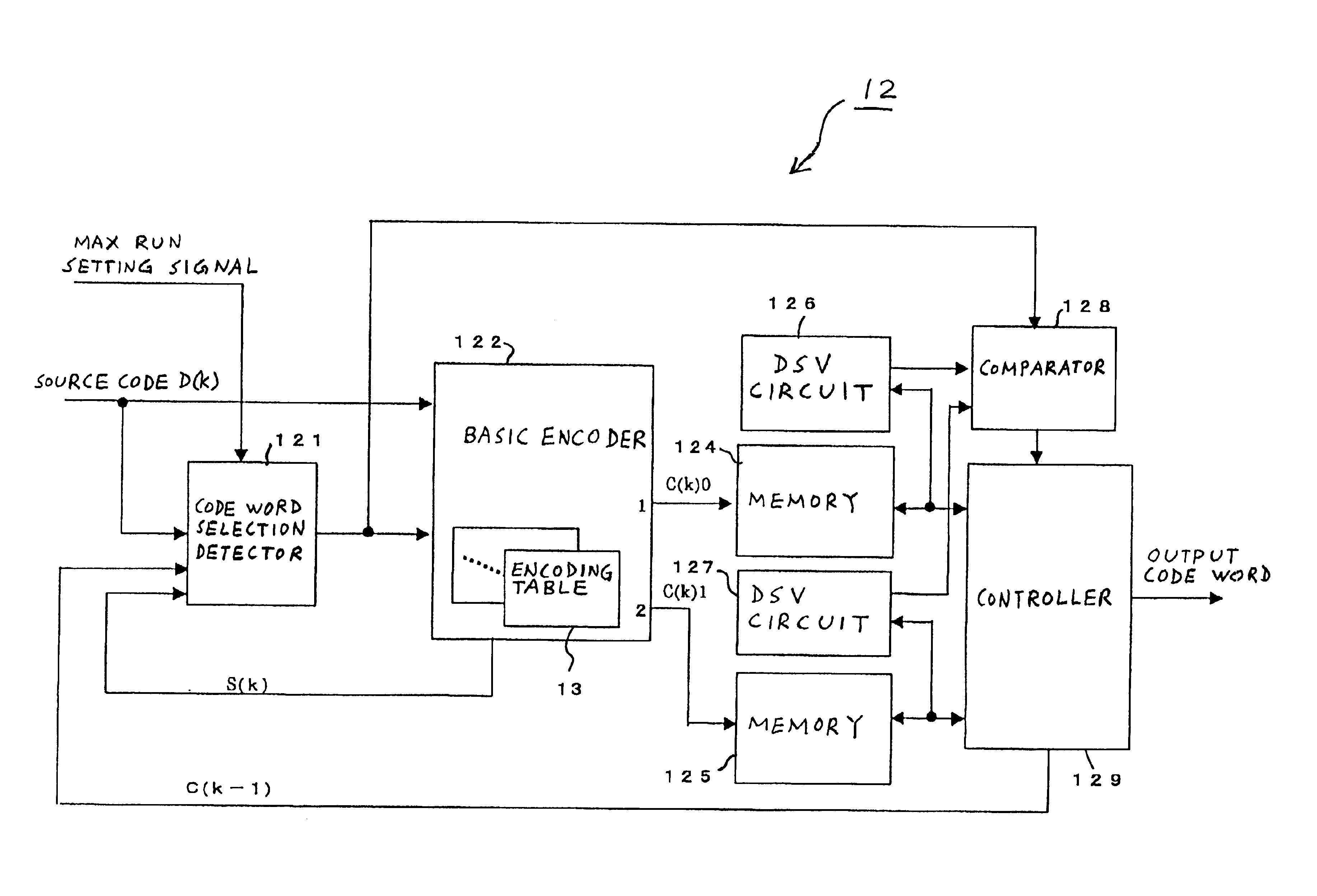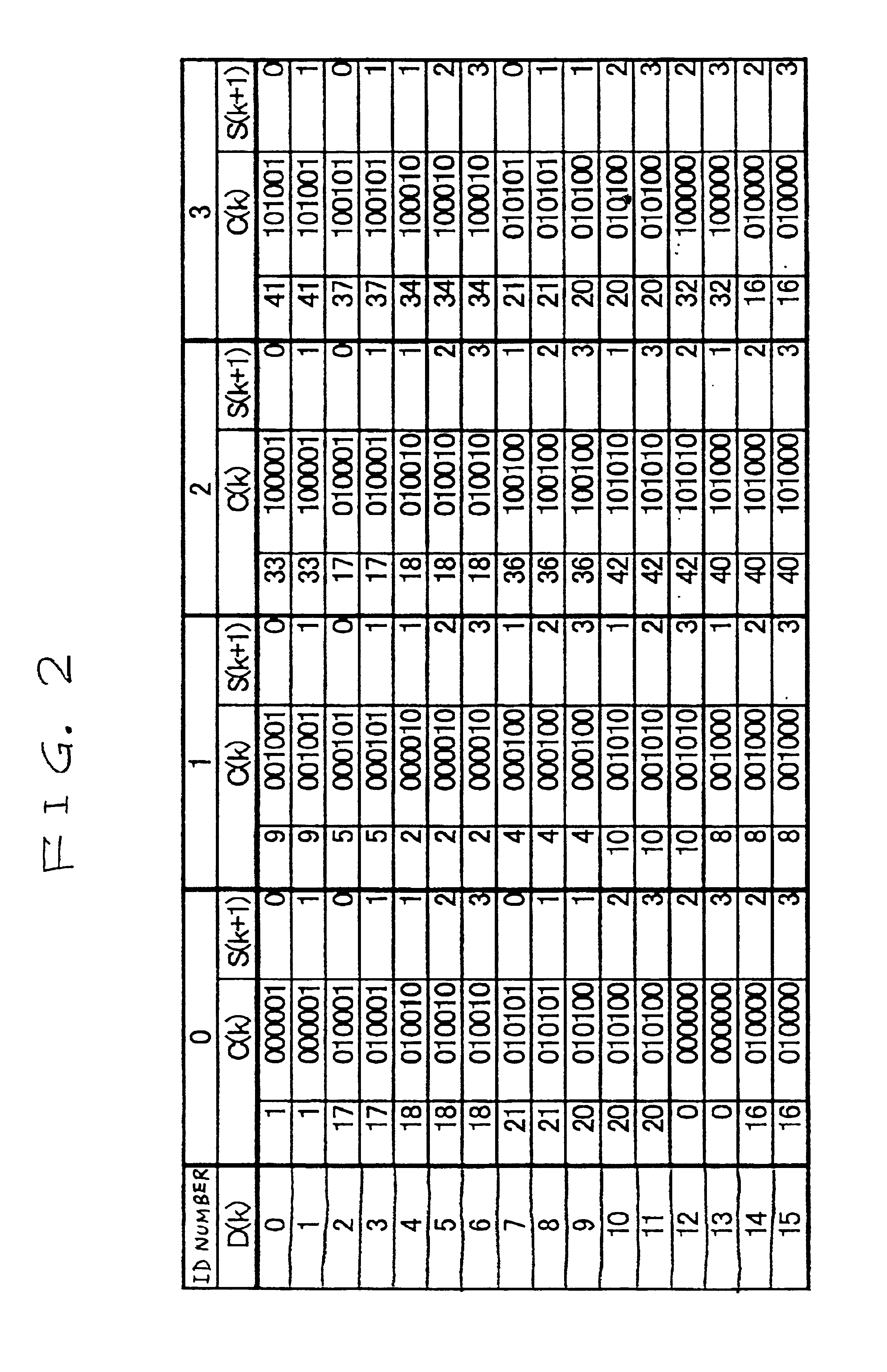Modulation system
a modulation system and modulation method technology, applied in the field of modulation methods, can solve the problems of information signal interference with servo control, insufficient suppression, etc., and achieve the effect of excellent encoding rate (encoding efficiency) and copy protection
- Summary
- Abstract
- Description
- Claims
- Application Information
AI Technical Summary
Benefits of technology
Problems solved by technology
Method used
Image
Examples
first embodiment
Run length limiting rules “(d, k)RLL” are such that “d” to “k” successive bits of “0” should be between bits of “1” in a modulation-resultant bit stream, where “d” and “k” denote predetermined natural numbers and the number “d” is smaller than the number “k”.
FIG. 1 shows 6-bit output code words which follow (1, 7)RLL or (1, 8)RLL. FIG. 2 shows an encoding table for converting or encoding every 4-bit input code word (every 4-bit input data word) into a 6-bit output code word. The encoding table in FIG. 2 uses 6-bit output code words listed in FIG. 1.
The encoding table in FIG. 2 has a set of four sub encoding tables having identification (ID) numbers of “0”, “1”, “2”, and “3” respectively. Each of the four sub encoding tables stores 6-bit output code words C(k) assigned to 4-bit input code words D(k). The four sub encoding tables contain arrays of cells at different addresses respectively. Each of the cells has a set of an input code word D(k), an output code word C(k) assigned to the...
second embodiment
FIG. 14 shows a demodulation apparatus 500 according to a second embodiment of this invention. The demodulation apparatus 500 receives an input bit stream divided into segments representative of input code words. The input bit stream is generated by, for example, the modulation apparatus 1 in FIG. 4. The input bit stream corresponds to, for example, the output signal of the NRZI converter 14 in FIG. 4. The demodulation apparatus 500 recovers main information and auxiliary information from the input bit stream. The demodulation apparatus 500 outputs the recovered main information and also the recovered auxiliary information. The demodulation apparatus 500 can reproduce original code words (the main information) from the input bit stream regardless of whether the run length limiting rules used by a modulation side are (1, 7)RLL or (1, 8)RLL.
As shown in FIG. 14, the demodulation apparatus 500 includes an NRZI demodulator 501, a sync detector 502, a serial-to-parallel (S / P) converter 50...
third embodiment
An auxiliary-information application system of a third embodiment of this invention includes the modulation apparatus 1 of FIG. 4 and the demodulation apparatus 500 of FIG. 14.
In the case where a digital information signal can be recorded on the recording medium 2 (see FIG. 4) at a data rate of 50 Mbps and every recording sector of the digital information signal has 2048 bytes, the auxiliary information can be recorded on the recording medium 2 at a data rate of about 3 kbps. For example, the auxiliary information includes picture encoding information which conforms with the H. 261 standards, the H. 263 standards, or the MPEG4 standards. Alternatively, the auxiliary information may include audio encoding information which conforms with the H. 723 standards or the AAC standards. The auxiliary information may include information which results from run length encoding or quantization of auxiliary-picture character information represented by bit map data in, for example, DVDs. The auxil...
PUM
 Login to View More
Login to View More Abstract
Description
Claims
Application Information
 Login to View More
Login to View More - R&D
- Intellectual Property
- Life Sciences
- Materials
- Tech Scout
- Unparalleled Data Quality
- Higher Quality Content
- 60% Fewer Hallucinations
Browse by: Latest US Patents, China's latest patents, Technical Efficacy Thesaurus, Application Domain, Technology Topic, Popular Technical Reports.
© 2025 PatSnap. All rights reserved.Legal|Privacy policy|Modern Slavery Act Transparency Statement|Sitemap|About US| Contact US: help@patsnap.com



